Por vs Para: When to Use Each in Spanish

Written by
Ernest Bio Bogore

Reviewed by
Ibrahim Litinine
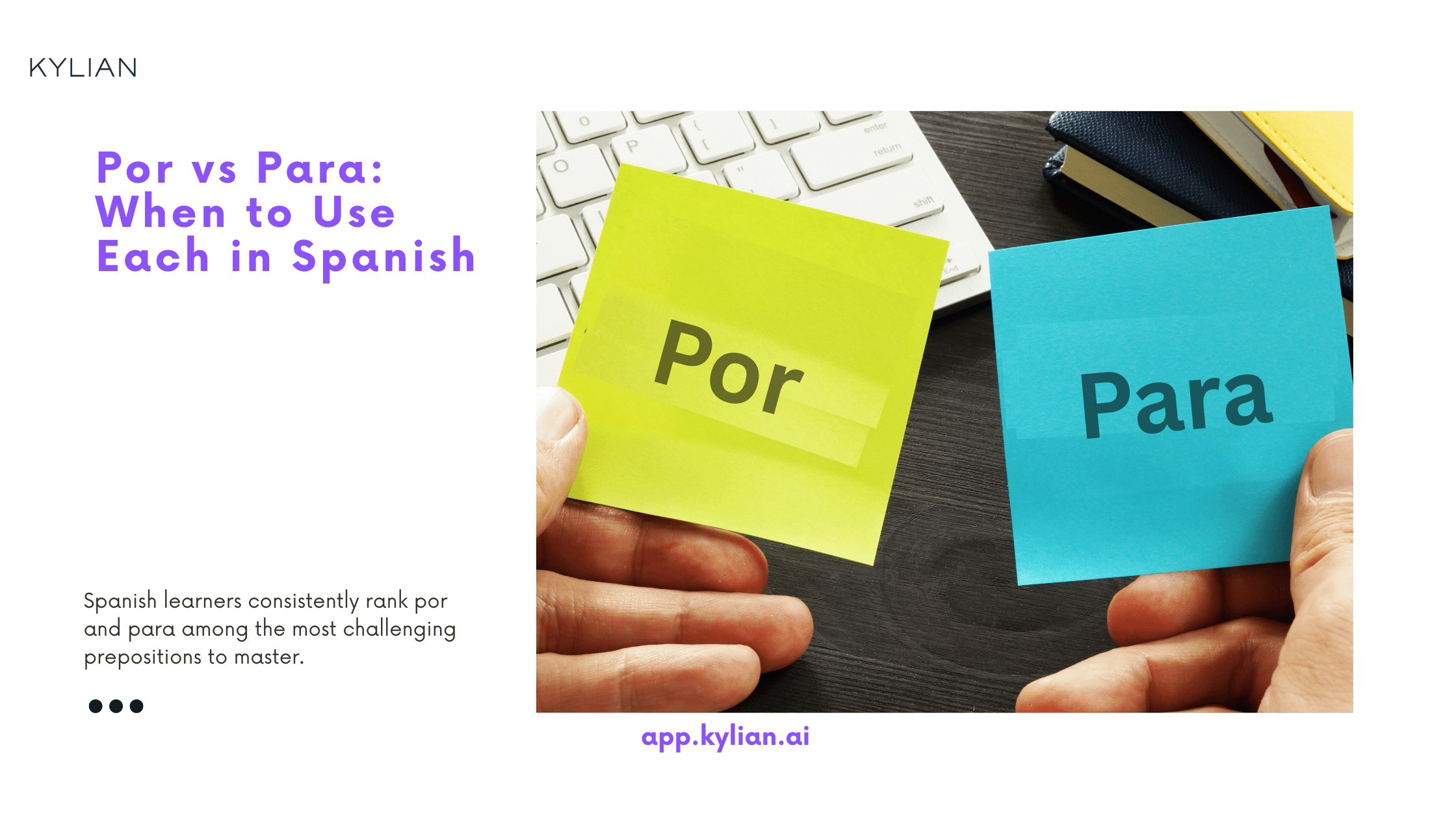
Spanish learners consistently rank por and para among the most challenging prepositions to master. This difficulty stems from a fundamental linguistic reality: both words frequently translate to "for" in English, yet they serve distinctly different grammatical and semantic functions that English doesn't distinguish.
The confusion runs deeper than simple translation issues. These prepositions appear in countless idiomatic expressions, carry subtle contextual meanings, and follow usage patterns that don't align with English logic. Understanding when to use each requires grasping conceptual differences rather than memorizing translation equivalents.
The Core Distinction Between Por and Para
The fundamental difference between por and para lies in their directional focus and conceptual approach to actions and states.
Por operates with an indirect, process-oriented mindset. It emphasizes the means, method, or journey rather than the endpoint. When you use por, you're typically describing how something happens, why it occurs, or the circumstances surrounding an action. This preposition suggests movement through spaces, duration of time, or the mechanism by which something is accomplished.
Para functions with direct, goal-oriented precision. It points toward specific destinations, purposes, deadlines, or recipients. Para indicates where something is heading, who will receive it, when it must be completed, or why it's being done with a clear objective in mind.
This distinction becomes clearer when examining parallel examples:
- "Camino por el parque" (I walk through/around the park) - emphasizes the route or general area
- "Camino para el parque" (I walk to the park) - specifies the destination
The difference reflects two ways of conceptualizing the same physical movement: one focusing on the process and path, the other on the target and purpose.
When to Use Por: Six Essential Applications
Expressing Motivation and Causation
Por serves as the primary preposition for indicating the underlying reason, motive, or cause behind an action. This usage answers the question "why" something happens, but from the perspective of what drives or compels the action.
Consider these applications:
"Llegamos tarde por el tráfico intenso" (We arrived late because of heavy traffic). The traffic represents the external force that caused the delay.
"Estudia medicina por su pasión de ayudar" (He studies medicine because of his passion to help). The passion serves as the driving motivation.
"Cerró la empresa por problemas financieros" (He closed the company due to financial problems). The financial issues forced the closure.
This usage of por emphasizes that external circumstances, internal motivations, or compelling forces drive the action. The focus remains on what pushes or influences rather than what pulls or attracts.
Indicating Duration and Temporal Scope
Por excels at expressing approximate time periods, habitual time frames, or duration of activities. This application focuses on the span of time rather than specific moments or deadlines.
Temporal applications include:
"Trabajé en esa oficina por cinco años" (I worked in that office for five years). The emphasis falls on the duration of employment.
"Prefiero estudiar por la tarde" (I prefer to study in the afternoon). This indicates a general time preference during afternoon hours.
"Estaré ocupado por toda la semana" (I'll be busy for the entire week). The focus is on the span of time being occupied.
The temporal use of por suggests ongoing states or processes that unfold over time rather than pinpointing exact moments or endpoints.
Describing Costs, Rates, and Exchanges
Por functions as the standard preposition for expressing prices, rates, exchanges, and mathematical relationships. This usage reflects proportional or equivalent relationships between quantities.
Economic and quantitative examples:
"Compré el libro por veinte dólares" (I bought the book for twenty dollars). The price represents the exchange value.
"El límite de velocidad es sesenta kilómetros por hora" (The speed limit is sixty kilometers per hour). This expresses a rate relationship.
"Cambié mi auto viejo por uno nuevo" (I traded my old car for a new one). The exchange involves equivalent value substitution.
This application of por emphasizes the relationship between quantities, whether in terms of money, rates, or proportional exchanges.
Indicating Location and Movement Patterns
Por describes general locations, approximate areas, or movement through spaces without specifying exact destinations. This usage suggests indefinite spatial relationships or passage through areas.
Spatial applications include:
"Los niños corren por el jardín" (The children run around the garden). The movement occurs within the general area without a specific target.
"Vivo por el centro de la ciudad" (I live around downtown). This indicates a general neighborhood rather than a precise address.
"Pasamos por varios pueblos pequeños" (We passed through several small towns). The movement involves traversing different locations.
The spatial use of por emphasizes the area or region of activity rather than precise coordinates or specific destinations.
Describing Methods of Communication and Transport
Por serves as the standard preposition for indicating the medium, method, or channel through which communication or transportation occurs.
Communication and transport examples:
"Le envié el documento por correo electrónico" (I sent him the document by email). The email serves as the delivery medium.
"Viajamos por avión hasta Madrid" (We traveled by plane to Madrid). The airplane represents the transportation method.
"Me enteré de las noticias por la radio" (I found out about the news through the radio). The radio functions as the information channel.
This usage focuses on the instrumental means rather than the content being communicated or the destination being reached.
Expressing Agency in Passive Voice
Por identifies the agent or performer of an action in passive voice constructions. This grammatical function clarifies who or what actually performs the action when the sentence structure emphasizes the recipient or result.
Passive voice applications:
"La novela fue escrita por García Márquez" (The novel was written by García Márquez). García Márquez is the actual author performing the writing.
"El problema fue resuelto por el equipo técnico" (The problem was solved by the technical team). The team performed the solving action.
"La decisión fue tomada por la junta directiva" (The decision was made by the board of directors). The board acted as the decision-making agent.
This usage of por maintains clarity about responsibility and agency even when sentence structure prioritizes other elements.
When to Use Para: Six Critical Functions
Specifying Destinations and Targets
Para indicates specific destinations, targets, or endpoints of movement or action. Unlike por's vague directional sense, para points precisely toward where something or someone is headed.
Destination examples:
"Mañana salgo para Barcelona" (Tomorrow I leave for Barcelona). Barcelona represents the specific travel destination.
"Este tren va para la estación central" (This train goes to the central station). The central station is the precise endpoint.
"Caminamos para la biblioteca después de clase" (We walk to the library after class). The library serves as the specific target location.
Para's directional usage eliminates ambiguity about intended destinations and emphasizes purposeful movement toward specific places.
Expressing Goals and Purposes
Para introduces purposes, objectives, and intended outcomes of actions. This usage typically involves infinitive verbs and emphasizes the intended result or goal being pursued.
Purpose-driven applications:
"Ahorro dinero para comprar una casa" (I save money to buy a house). House purchase represents the savings goal.
"Estudia idiomas para mejorar sus oportunidades laborales" (She studies languages to improve her job opportunities). Career advancement motivates the language study.
"Hacemos ejercicio para mantenernos saludables" (We exercise to stay healthy). Health maintenance drives the exercise routine.
This usage of para connects present actions with future intended outcomes, establishing clear causal relationships between effort and objectives.
Identifying Recipients and Beneficiaries
Para specifies who will receive, benefit from, or be affected by an action or object. This usage establishes clear relationships between actions and their intended recipients.
Recipient-focused examples:
"Compré este regalo para mi hermana" (I bought this gift for my sister). The sister is the intended recipient.
"Preparé la cena para toda la familia" (I prepared dinner for the whole family). The family members are the beneficiaries.
"Este medicamento es para pacientes con diabetes" (This medication is for patients with diabetes). Diabetic patients represent the target user group.
Para's recipient function eliminates confusion about who benefits from or receives the results of actions.
Establishing Deadlines and Time Limits
Para sets specific deadlines, time limits, or target dates for completion of tasks or achievement of goals. This temporal usage emphasizes finite time constraints rather than ongoing durations.
Deadline applications:
"Necesito terminar el proyecto para el viernes" (I need to finish the project by Friday). Friday represents the absolute deadline.
"La reunión está programada para las tres de la tarde" (The meeting is scheduled for three in the afternoon). Three o'clock marks the specific time target.
"Planificamos el viaje para el próximo verano" (We're planning the trip for next summer). Next summer serves as the target timeframe.
Para's temporal function creates urgency and specificity around time-sensitive commitments and goals.
Conveying Personal Opinions and Perspectives
Para introduces subjective viewpoints, personal opinions, or individual perspectives on situations or topics. This usage acknowledges that the statement reflects personal judgment rather than objective fact.
Opinion-based examples:
"Para mí, la comida italiana es la mejor" (For me, Italian food is the best). This expresses personal preference rather than universal truth.
"Para los expertos, esta decisión fue acertada" (For the experts, this decision was correct). The opinion belongs specifically to expert perspectives.
"Para alguien tan joven, tiene mucha experiencia" (For someone so young, he has a lot of experience). The assessment relates to age-based expectations.
This usage of para frames statements as perspective-dependent rather than absolute truths.
Highlighting Contrasts and Comparisons
Para introduces comparative statements that highlight unexpected contrasts or surprising relationships between different elements or expectations.
Comparative applications:
"Hace mucho frío para ser primavera" (It's very cold for spring). The coldness contrasts with spring weather expectations.
"Es muy maduro para su edad" (He's very mature for his age). Maturity level exceeds age-based expectations.
"El examen fue fácil para ser tan importante" (The exam was easy for being so important). Difficulty level contrasts with importance expectations.
This contrastive use of para draws attention to situations that deviate from normal patterns or expectations.
Common Expressions and Fixed Phrases
Both por and para appear in numerous idiomatic expressions where usage follows conventional patterns rather than logical rules. These expressions require memorization since their applications don't always align with the general principles outlined above.
Essential Por Expressions
- Por favor (Please) - Standard politeness marker
- Por ejemplo (For example) - Introduces illustrative cases
- Por fin (Finally) - Indicates long-awaited completion
- Por supuesto (Of course) - Expresses obvious agreement
- Por lo menos (At least) - Sets minimum expectations
- Por ahora (For now) - Indicates temporary timeframes
- Por eso (That's why/Therefore) - Shows causal relationships
- Día por día (Day by day) - Describes gradual processes
- Por casualidad (By chance) - Indicates accidental occurrences
- Gracias por (Thanks for) - Expresses gratitude for specific actions
Essential Para Expressions
- Para siempre (Forever) - Indicates permanent duration
- Para entonces (By that time) - References future timepoints
- Para que (So that/In order that) - Introduces purpose clauses
- Para variar (For a change) - Suggests deviation from routine
- Estar para (To be about to) - Indicates imminent action
Advanced Idiomatic Usage
Spanish includes numerous idioms incorporating por and para that don't follow standard translation patterns:
"Dar gato por liebre" literally translates as "to give cat for hare" but means "to deceive someone" or "to pass off something inferior as superior."
"Tirar la casa por la ventana" literally means "to throw the house out the window" but indicates "sparing no expense" or "going all out."
These idioms demonstrate how por and para usage can transcend logical grammatical rules and enter purely conventional territory.
Advanced Usage Patterns and Subtle Distinctions
Context-Dependent Variations
Certain contexts create subtle meaning shifts that affect por versus para choice even when both might seem grammatically acceptable.
Consider temporal expressions:
- "Trabajo por la mañana" (I work in the morning) - indicates habitual morning work
- "Trabajo para la mañana" (I work for the morning) - suggests work specifically targeted at morning completion
The distinction reflects whether morning represents the time frame of activity (por) or the deadline for completion (para).
Regional and Stylistic Variations
Different Spanish-speaking regions occasionally show preferences for por or para in similar contexts, though core grammatical rules remain consistent. Professional and academic writing tends toward more precise para usage for goals and deadlines, while conversational Spanish may blur distinctions in casual contexts.
Error Patterns and Learning Strategies
English speakers commonly overgeneralize por usage because English "for" covers many por functions but fewer para applications. This leads to errors like using por for destinations ("voy por la tienda" instead of "voy para la tienda") or deadlines ("necesito esto por mañana" instead of "necesito esto para mañana").
Effective learning strategies include:
Conceptual thinking: Instead of memorizing translations, internalize the process-versus-goal distinction that underlies most por/para differences.
Context analysis: When encountering por or para in authentic Spanish materials, analyze why that specific preposition was chosen based on the communicative intent.
Pattern recognition: Identify common sentence structures that typically require por (passive voice, duration expressions) versus para (infinitive purposes, recipient phrases).
Practical Application and Mastery Strategies
Diagnostic Questions for Por vs Para
When uncertain about preposition choice, asking specific diagnostic questions can clarify the appropriate option:
For Por consideration:
- Does this express how, why, or through what means something happens?
- Am I describing duration, approximate time, or ongoing processes?
- Is this about movement through or around areas rather than to specific destinations?
- Does this involve rates, exchanges, or proportional relationships?
For Para consideration:
- Am I specifying where something is going or who will receive it?
- Does this express a purpose, goal, or intended outcome?
- Am I setting a deadline or specific time limit?
- Is this introducing a personal opinion or making a comparison against expectations?
Progressive Learning Approach
Mastering por and para requires graduated exposure starting with high-frequency, clear-cut cases before progressing to subtle distinctions and idiomatic usage.
Foundation level: Focus on destination (para) versus movement through areas (por), and purposes with infinitives (para) versus duration expressions (por).
Intermediate level: Add recipient relationships (para), causal explanations (por), deadline setting (para), and communication methods (por).
Advanced level: Incorporate opinion markers (para), contrastive usage (para), passive voice agency (por), and common idiomatic expressions for both prepositions.
Integration with Broader Spanish Grammar
Por and para usage intersects with other grammatical elements including verb tenses, sentence structure, and discourse markers. Understanding these connections strengthens overall preposition mastery.
Subjunctive triggers: "Para que" typically requires subjunctive mood in dependent clauses, while "por" constructions generally use indicative mood.
Infinitive patterns: Para commonly precedes infinitive verbs expressing purposes, while por rarely appears in this pattern.
Passive voice: Por almost exclusively handles agent marking in passive constructions, while para never serves this function.
Learn Any Language with Kylian AI
Private language lessons are expensive. Paying between 15 and 50 euros per lesson isn’t realistic for most people—especially when dozens of sessions are needed to see real progress.
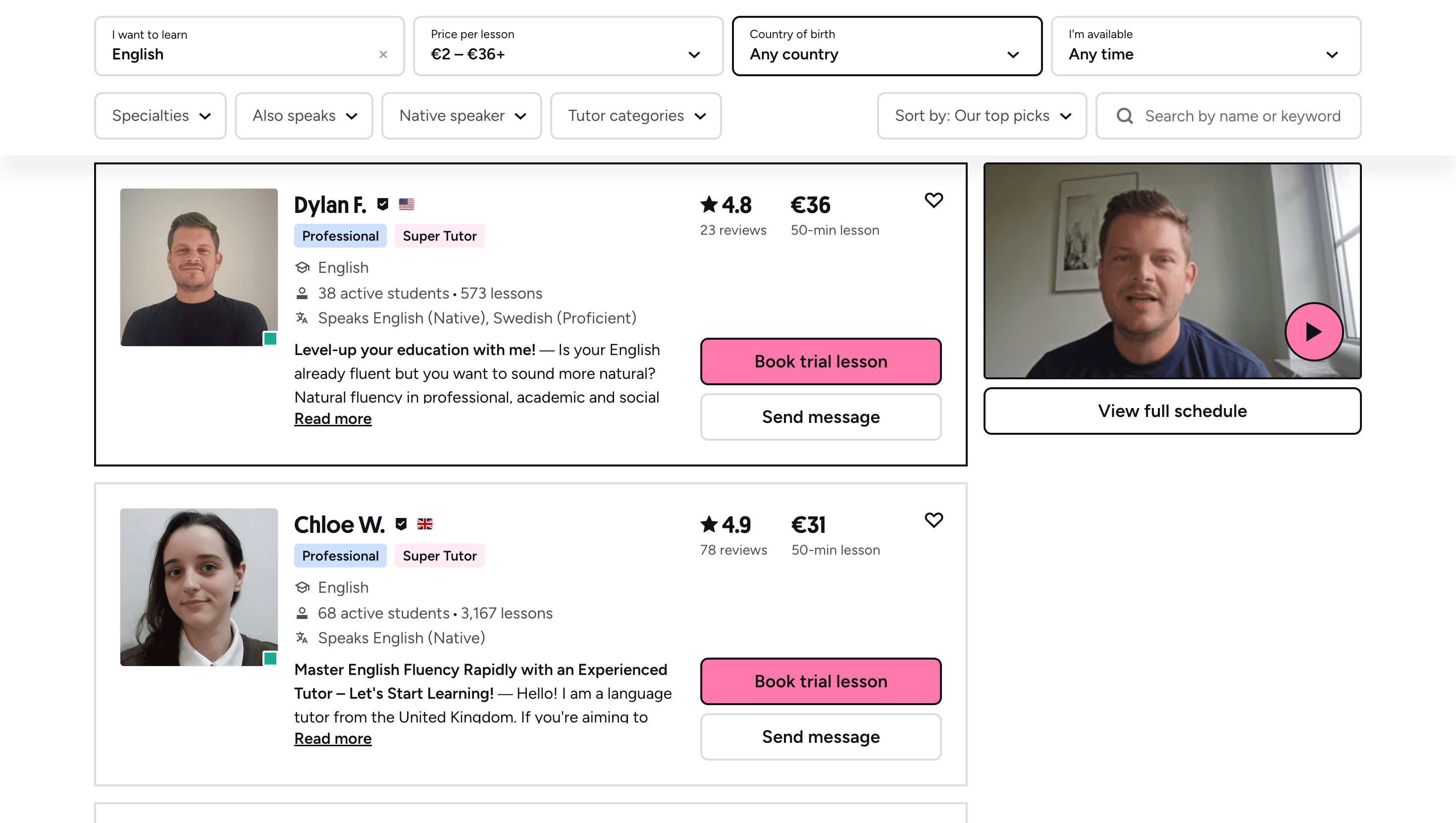
Many learners give up on language learning due to these high costs, missing out on valuable professional and personal opportunities.
That’s why we created Kylian: to make language learning accessible to everyone and help people master a foreign language without breaking the bank.
To get started, just tell Kylian which language you want to learn and what your native language is
Tired of teachers who don’t understand your specific struggles as a French speaker? Kylian’s advantage lies in its ability to teach any language using your native tongue as the foundation.
Unlike generic apps that offer the same content to everyone, Kylian explains concepts in your native language (French) and switches to the target language when necessary—perfectly adapting to your level and needs.
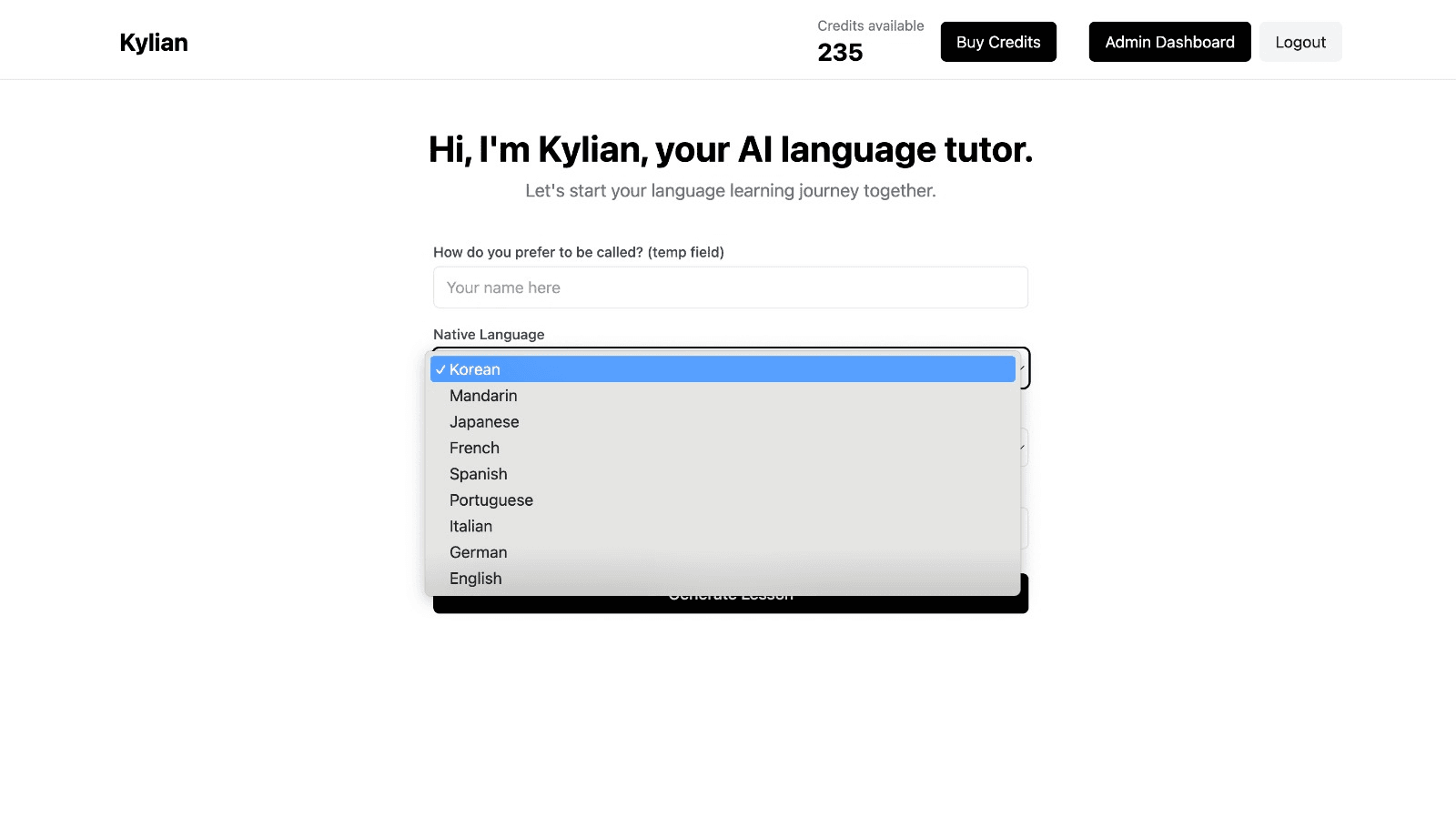
This personalization removes the frustration and confusion that are so common in traditional language learning.
Choose a specific topic you want to learn
Frustrated by language lessons that never cover exactly what you need? Kylian can teach you any aspect of a language—from pronunciation to advanced grammar—by focusing on your specific goals.
Avoid vague requests like “How can I improve my accent?” and be precise: “How do I pronounce the R like a native English speaker?” or “How do I conjugate the verb ‘to be’ in the present tense?”
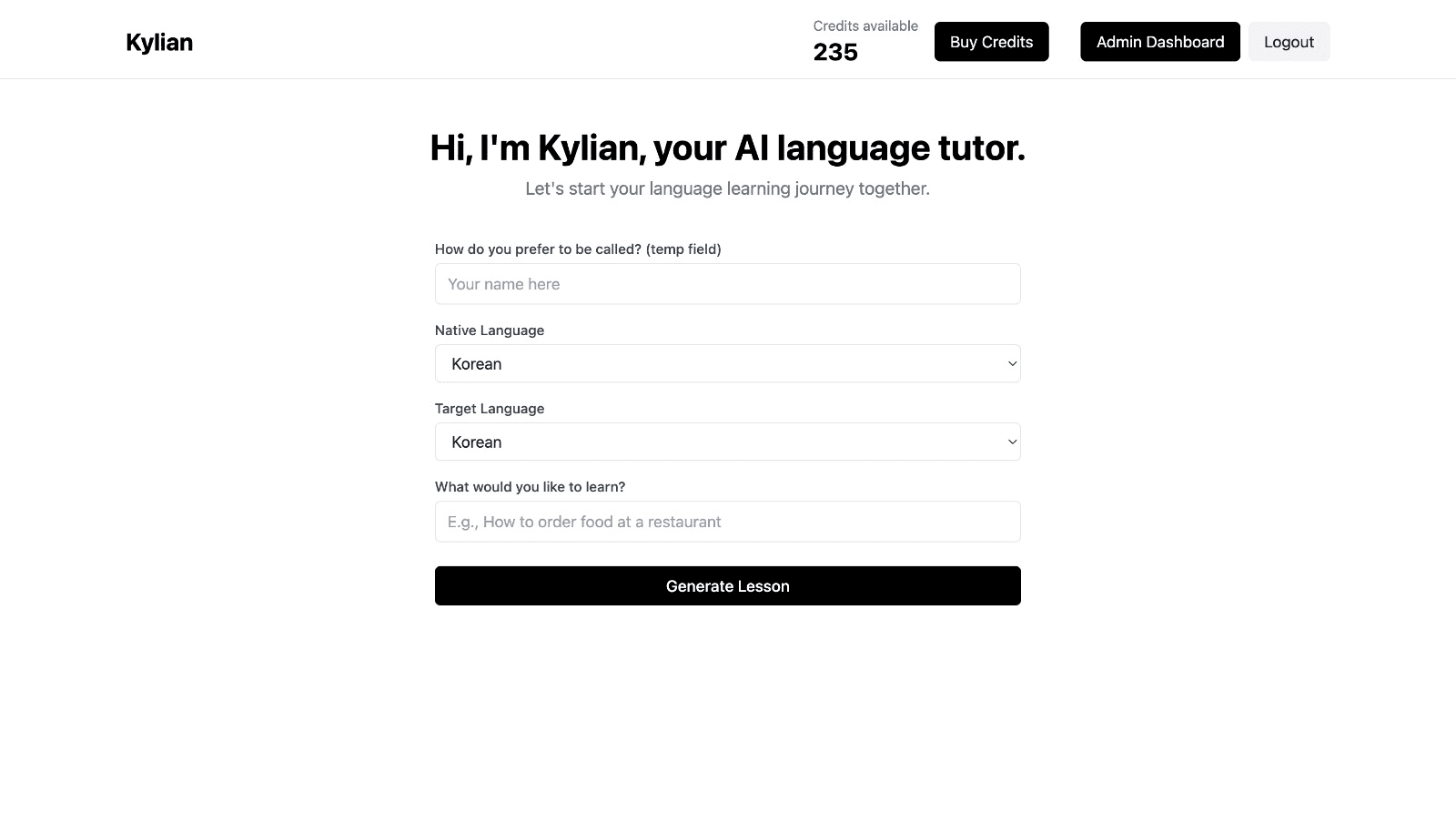
With Kylian, you’ll never again pay for irrelevant content or feel embarrassed asking “too basic” questions to a teacher. Your learning plan is entirely personalized.
Once you’ve chosen your topic, just hit the “Generate a Lesson” button, and within seconds, you’ll get a lesson designed exclusively for you.
Join the room to begin your lesson
The session feels like a one-on-one language class with a human tutor—but without the high price or time constraints.
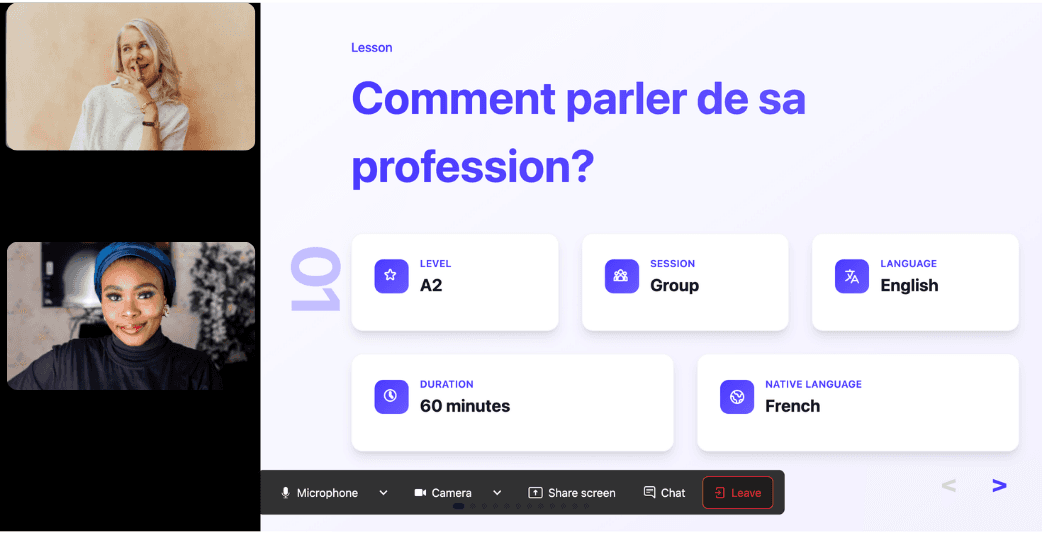
In a 25-minute lesson, Kylian teaches exactly what you need to know about your chosen topic: the nuances that textbooks never explain, key cultural differences between French and your target language, grammar rules, and much more.
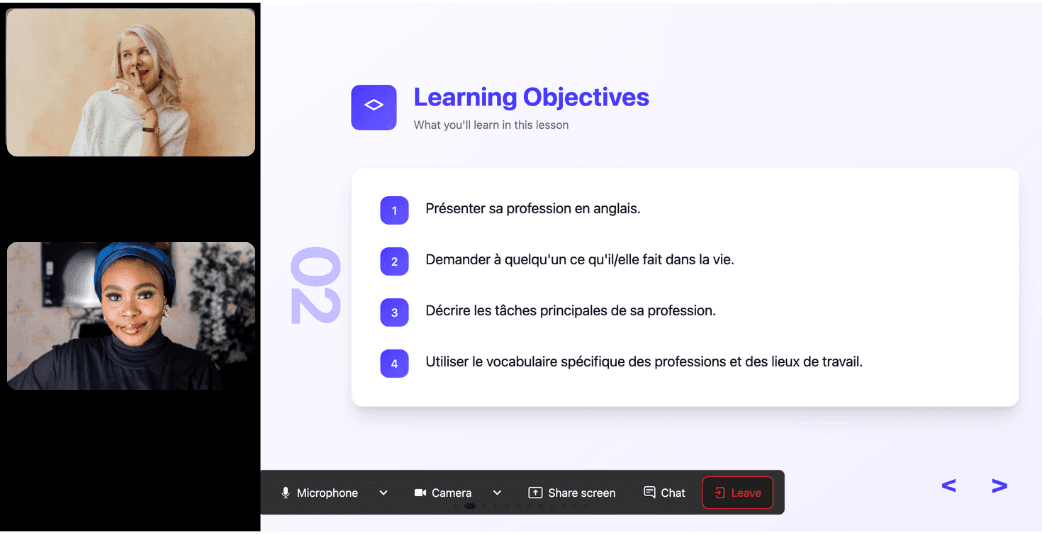
Ever felt frustrated trying to keep up with a native-speaking teacher, or embarrassed to ask for something to be repeated? With Kylian, that problem disappears. It switches intelligently between French and the target language depending on your level, helping you understand every concept at your own pace.
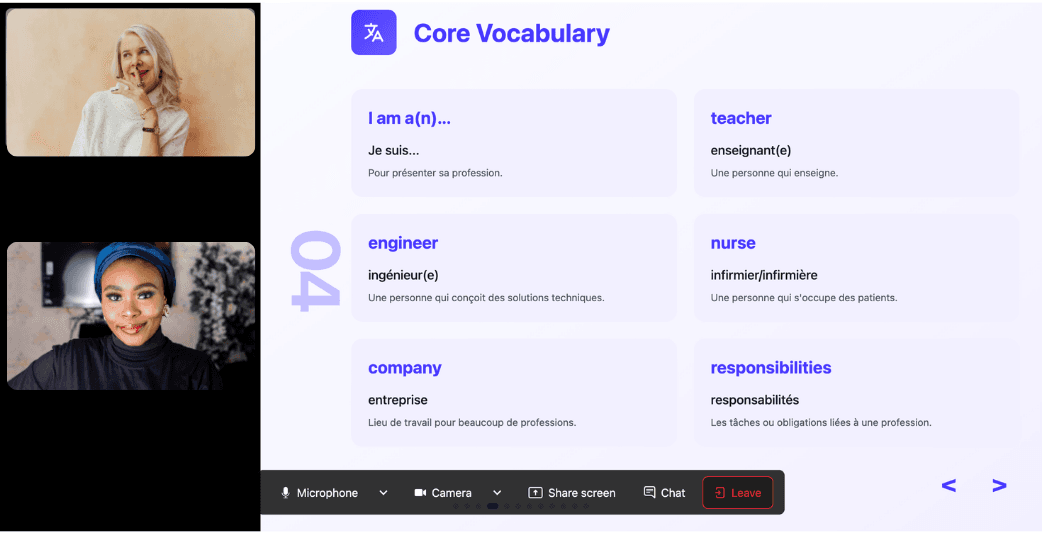
During the lesson, Kylian uses role-plays, real-life examples, and adapts to your learning style. Didn’t understand something? No problem—you can pause Kylian anytime to ask for clarification, without fear of being judged.
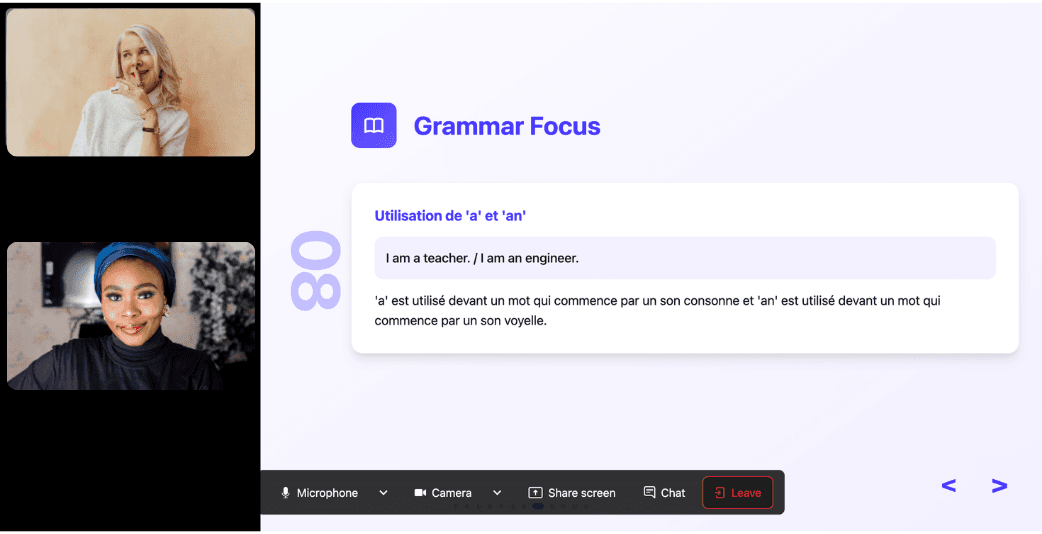
Ask all the questions you want, repeat sections if needed, and customize your learning experience in ways traditional teachers and generic apps simply can’t match.

With 24/7 access at a fraction of the cost of private lessons, Kylian removes all the barriers that have kept you from mastering the language you’ve always wanted to learn.
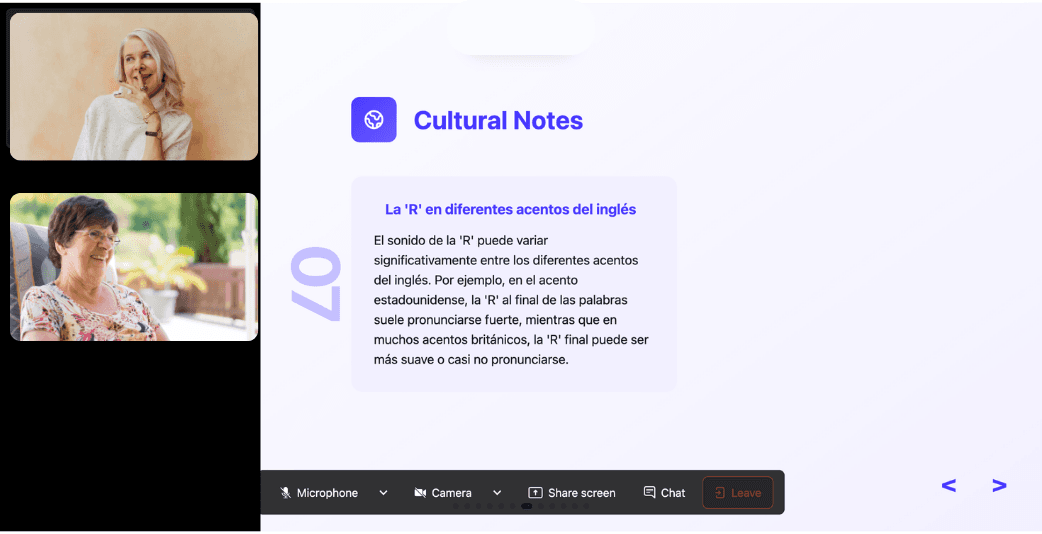
Similar Content You Might Want To Read

Job Interview in English: Tips + Common Questions
Job interviews conducted in English present a unique challenge that extends far beyond language proficiency. The intersection of professional communication, cultural nuances, and technical vocabulary creates a complex landscape that demands strategic preparation. Most candidates approach English interviews with the misguided assumption that conversational fluency translates to interview success—a critical error that costs opportunities. The reality is stark: according to recent hiring data, non-native English speakers face rejection rates 23% higher than native speakers, not due to technical incompetence, but because of communication gaps during interviews. This disparity isn't about fairness—it's about preparation gaps that can be systematically addressed. Success in English interviews requires understanding three fundamental layers: linguistic precision, cultural communication patterns, and industry-specific terminology. Each layer builds upon the previous, creating a framework that transforms interview anxiety into confident professional presentation.

Por qué vs. porque: Nuance Between These Spanish Words
Learning Spanish comes with several fascinating challenges, particularly when distinguishing between words that sound identical but serve completely different grammatical functions. The por qué/porque distinction represents one of these critical language hurdles that even native speakers occasionally stumble over. Why does this matter? Because misusing these terms can transform your carefully crafted sentence from perfectly clear to confusingly ambiguous. Understanding the distinction isn't just about grammatical correctness—it's about effective communication.

Reflexive Verbs in Spanish: A Comprehensive Guide
Learning a language requires mastering its core grammatical structures. Among these, reflexive verbs in Spanish represent a fundamental concept that dramatically enhances fluency and authenticity in conversation. This comprehensive guide offers clear explanations, actionable strategies, and contextual examples to help you incorporate reflexive verbs naturally into your Spanish communication. Let's explore this crucial element of Spanish grammar to elevate your language proficiency.

Spanish vs Italian: Decisive Guide for Language Enthusiasts
Choosing your next language learning journey requires careful consideration. When contemplating Romance languages, Spanish and Italian often emerge as top contenders. Both offer rich cultural heritage, practical applications, and accessible learning curves for English speakers. This guide dissects the critical differences and similarities to help you make an informed decision aligned with your personal goals.

Proficient At, With, or In? Learn Preposition Use in English
Language precision matters. The subtle difference between saying "proficient at coding," "proficient in coding," or "proficient with coding" might seem inconsequential to many English learners, but these preposition choices reveal deeper linguistic patterns that impact communication clarity. The challenge of selecting the right preposition after "proficient" represents a common stumbling block even for advanced English speakers. Why does this distinction matter? Because precision in language signals competence. When professionals describe their skills on resumes, during interviews, or in workplace communications, the preposition they pair with "proficient" subtly shapes how others perceive their expertise. These small linguistic choices build credibility—or undermine it. This guide examines the nuanced differences between "proficient at," "proficient with," and "proficient in," providing clear guidance on when to use each construction. By understanding these distinctions, you'll communicate more precisely and project greater language mastery.

Essential Spanish Grammar: Your Complete Guide
Learning Spanish requires understanding its grammatical foundation—the structural framework that allows you to communicate effectively. Rather than viewing grammar as a collection of rules to memorize, consider it the blueprint that enables you to express yourself accurately in this beautiful language. This comprehensive guide breaks down essential Spanish grammar concepts into digestible sections, giving you a practical reference you'll return to throughout your language journey.